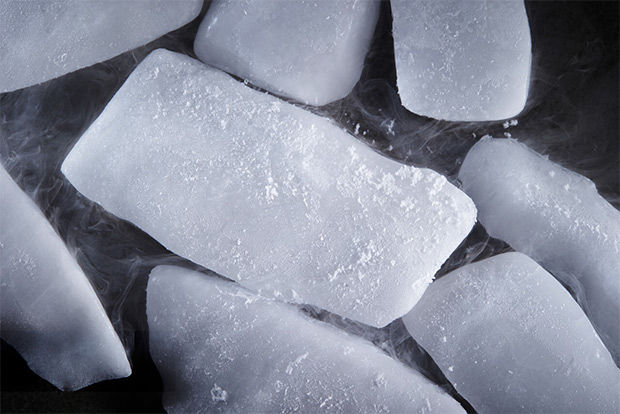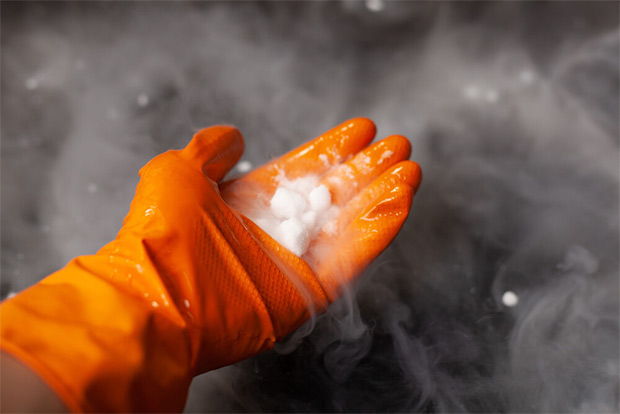Dry Ice User Guide: What is It Used for? How Long Does Dry Ice Last?
It can be used to preserve fresh food and quickly cool down drinks in coolers and portable freezers during camping trips, picnics, or long-distance trips. In emergency situations, such as during a blackout, dry ice can also be highly useful at maintaining temperature in your defunct refrigerators and freezers.
If you want to use it correctly and effectively, you need to know the answers to the question: “How long does dry ice last?”. This article will help you with exactly that and more!

What Do People Use Dry Ice For?
People don’t just use dry ice to keep their food fresh, their drinks cold, and their fridge running during emergencies like I just mentioned. There are dozens of different use cases for dry ice, both at home, work, and in-between.
At home, you can use it when you need to ship or transport easily-spoiled cargo like food or meat. Just pack a lot of ice into the shipping vessel (usually a heavy-duty cooler), throw it into the car, and whatever inside will easily last for several days of travel.
Commercial cargo delivery also uses dry ice for products that can get spoiled or damaged if they’re subjected to room temperature. Chocolate, for example, is usually shipped in a dry ice-cooled box to prevent it from melting down into chocolatey liquid by the time it reaches your door.
A lot of people have also used dry ice to make mosquito traps. Mosquitoes are naturally attracted to CO2, which is exactly what dry ice is. A block of dry ice when sublimated into CO2 vapor has the same attractiveness to mosquitoes as a group of a thousand people. As a result, it’s perfect for luring away mosquitoes or driving them into traps.
For anglers and hunters (both professional or amateur) who have to preserve wild game or freshly-caught fish, dry ice is also a far more compelling option than normal ice. When ordinary ice melts, the left-over water that coats the meat can spur bacterial growth. On the other hand, dry ice simply sublimates (turning into CO2 vapor) so there’s no such risk. Furthermore, the super cold temperature of dry ice (-109°F) can instantly kill all living organisms that it touches. So dry ice doesn’t just make preserving freshly-hunted meat less messy, but it also has an antimicrobial, anti-spoiling effect.
Dry ice is also commonly used by plumbers to freeze up water pipes during maintenance, fix up dents on cars by mechanics, used by teachers for fun scientific experiments, and also in medical settings as a disinfectant or cryotherapy. And for those who are into theatrics, dry ice’s smoky sublimation is also the perfect special effects for dramas!
As you can see, there are so many things that you can do with a pack of dry ice. However, as I said before, to use them correctly and most effectively, you need to be aware of how long a block is going to last.
➜ RELATED: RTIC 65 Cooler: Super-Great Alternative Option To Other High-End Coolers
How Affordable Is Dry Ice And Where Do I Find It?
For people who haven’t used dry ice before, dry ice cost is very affordable. Depending on where you buy it from, dry ice usually costs between $1 to $3 per pound. You can also find it anywhere, really. Grocery stores like Walmart and Costco sell it in bulk. Just ask the employees there and they will point out where you need to go.
Here’s a small shopping tip: buy it in bulk, avoid buying small blocks at a time. There are usually bulk discounts at most outlets, so buying dry ice in individual, small prefabricated slabs will usually cost you a few extra cents ($1.1 to $1.3 per pound). Those few extra cents can quickly add up when you need dozens of pounds at once.
➜ RELATED: Yeti 75 Cooler: A High-End Model Made for the Wild
How Long Will Dry Ice Last On Average?
This isn’t a simple question to answer. The time that a block of dry ice can last depends on two variables: the storage condition and the size of the block.
Storage Condition
The more isolated and insulated the storage environment is, the longer dry ice can last.
So how long does dry ice last in a cooler?
Well, if you store dry ice inside of a sealed-off cooler with strong insulation, a pack of dry ice can easily last for several days. If your cooler’s insulating capability is limited, the number of hours could be lowered down to 16 or 24 hours on average.
On the other hand, if you leave dry ice out in the open, it usually only takes about 3 or 5 hours before it is entirely vaporized.
Dry ice evaporates most quickly when it’s immersed inside of a liquid. In this scenario, they can sublimate in 15 or so minutes. It’s because of this very reason that you’re usually instructed to dry off your cooler as much as possible before putting in dry ice.
Block Size
It typically takes 5 to 10 pounds of dry ice to sublimate in 24 hours. Always keep this in mind while you’re measuring the amount of dry ice to use.
So let’s say you need to preserve your food inside of a cooler for two days. Pack between 20 pounds of dry ice inside of the cooler if you can. There should still be a little bit of leftover ice for the cooler’s contents to stay cold by the time you reach home or your destination.
If your cooler doesn’t have the capacity to store 30 pounds of dry ice at once, take the time to replenish the dry ice inside of the cooler after 24 hours or so.
➜ RELATED: Yeti Tundra 65 Quart Dimensions: Cooler for Outdoor Enthusiasts
How to Use Dry Ice In A Cooler
A cooler is the most popular way for people to make use of their dry ice. This is also my recommended method if you ever need to make use of dry ice, as well. Dry ice is generally most effective when it is properly packed inside of a good cooler.
The keyword here is “properly packed”. It’s not as simple as throwing as much dry ice into the box as you can and packing the whole thing full. There are actually serious techniques to pack a cooler with dry ice that you’ll have to learn.
See If Your Cooler Is Compatible With Dry Ice
Even though dry ice is a very popular way to keep things cool inside of a cooler, not every cooler model is designed to work with dry ice. Thus, it’s very important that you check the user’s manual to see if the cooler is able to work with dry ice or not.
Attempting to use dry ice with an incompatible cooler will usually result in irreversible damage to your cooler. Coolers that can be used with dry ice usually have extra padding and protection inside to protect it from dry ice’s steep coldness. Without these extra protection, dry ice could freeze up all of the spots it touches and permanently damage the cooler.
Additionally, coolers that are compatible with dry ice usually come with a vent system. The product of dry ice’s sublimation— CO2 gas— has to be vented. If they don’t and the pressure builds up to a dangerous point, your cooler could explode.
➜ RELATED: Yeti 45 Cooler: Best Rotomolded Cooler for Adventurers
Consider Your Cooler Size
Cooler size plays a major factor in deciding what the answer to your “How much dry ice do I need” question would be.
Generally speaking, the larger the cooler, the more ice you will need to cool the internal atmosphere down to the correct temperature.
Starting with a mid-size 25-quart cooler, it takes approximately 24 hours for 10 pounds of dry ice to sublimate from within. If you only need the cooler’s contents to stay cold for about a day, pack accordingly. However, if you need 48 hours of cooling, pack 15 pounds.
In case you need more cooling time than 48 hours, you may need to replenish the cooler manually with fresh ice.
For a larger 50-quart cooler, to cool between 12 to 24 hours means using approximately 15 pounds of dry ice. To extend to 48 hours, add 5 pounds more to 20 pounds.
Last but not least, if you have a super-sized 100-quart cooler, use 20 pounds if you want to cool for 12 hours, 25 pounds for 24 hours, and 35 pounds for 48 hours.
Keep in mind that this is a rough estimate of how much dry ice you will need. All coolers are designed differently and thus have different performance levels. You may have different results in reality, but they shouldn’t stray too far from the above numbers.
How to Deal With Refrigerated Vs. Frozen Food Items
There are two categories of food items you can put into your cooler: refrigerated (or chilled) items and frozen items.
Refrigeration happens at above-zero temperatures between 37 and 45°F. Refrigerated food typically doesn’t need to be defrosted and can be immediately brought out for processing and cooking. Additionally, refrigeration doesn’t suck out moisture from your food items. This is why perishable food ingredients with high water content like vegetables are usually refrigerated instead of frozen.
The disadvantage to refrigerating is that bacteria would still be active. However, their activities are greatly slowed down due to the cold temperature. Spoilage would still occur in a couple of hours, but it’s better than leaving your food non-refrigerated at all.
Frozen foods, on the other hand, are chilled to sub-zero temperatures (below 15°F). At such extreme temperatures, all bacterial activities on your foods are ceased. This is why frozen food ingredients are able to stay fresh for such a long time.
One special thing about freezing food with dry ice is that, due to its extremely low temperature, it can induce what’s known as flash freezing. Freezing using normal, wet ice needs a few hours up to a day to get the food’s internal temperature down to freezing temperature. With dry ice, the whole thing can be done in just a few hours, even minutes.
As for how long will dry ice keep food frozen, as long as there are still shreds of solid dry ice inside of the cooler, the food will still be able to remain solidly frozen.
Frozen food items must be defrosted when you finally take them out of the cooling box. Of course, this is going to be an issue if you wish to get started on your cooking immediately.
The second con to the frozen method is that freezing will drain away all of the moisture inside of your food. This can either be a good thing or a bad thing depends on what you’re trying to freeze. Meat and dairy, for example, don’t have very high water content. As a result, frozen meat and dairy taste virtually the same once they’re frosted.
But this rule doesn’t apply to vegetables and fruits, however. If you have ever tried frozen veggies before, you will immediately notice the difference in taste between them and refrigerated or fresh veggies. A good portion of their taste is thanks to moisture, after all.
How to Pack Refrigerated Items
Because dry ice is way too cold, you can’t really depend on it to keep your food at refrigeration level. This is where ordinary ice cubes come in. The dry ice’s job is to keep a layer of regular ice (which serves as the primary cooling agent) cold. It doesn’t directly participate in the cooling process.
The first thing you need to have at hand is some wrapping paper. You can use old newspapers or ripped-off pages from notebooks if you like. The paper is going to act as a thermal insulator for the dry ice in order to keep its super-cold temperature in check.
Wrap up the dry ice with all of the paper you got into a rectangle about the width and length of the cooler’s bottom. Make sure to wear safety gloves while you’re doing this. The temperature of dry ice can definitely give you a cold burn if it comes into direct contact with your unprotected skin.

Place the wrapped-up bundle of dry ice at the bottom of the cooler. After that, pour a layer of regular ice on top.
Place all of the items you need refrigerated on top of this thin layer of regular ice.
Once everything’s in place, pour another layer of regular ice over the top of all of the items. This top layer should be quite thick to insulate the contents from the heating effect of the sun boring down on the top lid (if you plan on bringing the cooler outside.) As such, pour as much ice as possible until they bury the item or at least reaches the lid. You will want to have as little air and empty space as possible inside of the cooler once you’re done.
How to Pack Frozen Items
Packing frozen items is less complicated. The whole process involves solely dry ice.
Start it up by also doing the newspaper-wrapping trick I mentioned earlier: pour dry ice onto some newspaper and wrap it all up into a tight rectangle(while wearing safety gloves.)
For this method to work, you need 2 of these packages.
Place one dry ice package at the bottom of the cooler, then place everything you need to be frozen on top. Once that’s done and over with, place the second package on top of all your items.
You can then close the lid!
How Long Does Dry Ice Last In A YETI?
One of the best coolers on the market right now is YETI. People from all sorts of backgrounds— normal college students, picnickers, hikers, to hunters and fishers who need especially rigorous insulating capability— only have a lot of good words for the brand.
So how long does dry ice last in a YETI?
Very long, in fact. It’s been reported by many YETI Tundra Haul cooler from past users that the 45-quart cooler has decent enough dry ice-keeping performance to last for 2-3 days. You can expect more or less the same level of performance with other YETI Tundra models.

But if you currently have a YETI at hand, however, you should make sure that your model is compatible with dry ice. Not every single model in the company’s portfolio is made for it. You can use this link to check.
How to Use Dry Ice For Shipping?
Like I mentioned before, dry ice is a very compelling option for shipping of specific cargo that has to be preserved at low temperature such as fresh meat, chocolate, medical supplies.
If you use postal services or similar shipping and logistic services, many of them will replenish dry ice for you during the transportation process to avoid spoilage or damage. Especially if the time-to-destination is long. Just inform them that you require the extra service.
How Long Does Dry Ice Last For Shipping?
Most of the items that have to be kept cold and insulated are shipped inside of styrofoam boxes. A 1-pound bag of dry ice can last anywhere between 12 to 24 hours inside of these boxes. Having 2 of these bags inside of the shipping box and you could get between 18 to 36 hours before the dry ice evaporated.
Styrofoam Shipping Boxes: Take Them Seriously
Those styrofoam shipping boxes may not look as cool as your YETI cooler, but they’re excellent for storing items that require insulation.
Even a box with thin walls will be able to preserve a block of dry ice for a couple of hours. Boxes with especially thick walls that are made for transporting vital, cold-preserved items like medical supplies can keep cold for days.
The consensus for shipping with styrofoam boxes is that if the transportation takes only 1 day or less, use a thin wall box. If it takes 2-3 days, use one with thicker walls. If it takes weeks, inform the courier service to replenish the dry ice while the box is being transported.
But styrofoam boxes are loved in logistics not just for their insulating performance. They’re also very cheap and light. Because courier services will price your shipping cost by poundage, you will want the shipping box to be as light as possible. That’s why shipping your things using your multi-pound, hundred-dollar YETI cooler, while possible, is neither economical nor wise.
➜ RELATED: Yeti Tundra 35 Cooler: Best Entry-level Cooler for All
How to Pack Dry Ice Into A Styrofoam Box
Fortunately, packing dry ice using a styrofoam shipping box isn’t at all different from packing a cooler. You can use the cooler-packing techniques that I detailed above step-by-step and the result will still be the same.
How to Use Dry Ice For Emergency Cooling
People who live in disaster-prone areas or in regions with a fickle power grid tend to have a supply cache of dry ice at the ready somewhere around the house for when the electricity goes out. The only thing that’s worse than going without power in the first place is going without power and having your food supply being spoiled.
Without power, your refrigerator and freezer will be able to keep themselves decently cold for up to 24 hours. Some high-end models with better insulation can even keep the temperature low for up to 48 hours at a time. However, actual mileage may also vary depending on how well-stocked your fridge or freezer is. The more produce and items there are inside, the quicker the temperature will rise.
When the internal temperature of your fridge/freezer becomes unnervingly warm and you see little chances of getting power back on anytime soon before the food becomes spoiled, pull out the dry ice!
➜ RELATED: Top 3 Ways On How To Clean A Dirty Cooler And Sanitize It Too
How Much Dry Ice to Use In Emergencies?
The low temperature of dry ice can replace the cooling system inside of your fridge/freezer and keep everything cooled and safe for you.
If you have a small freezer, between 25 or 30 pounds of dry ice will be decent for keeping the contents cold for a day. But if you have a large-capacity freezer, it’s recommended to stock the freezer with 3 pounds of dry ice per cubic foot of internal space.
Refrigerators need less because, like previously explained, you don’t need (or want) the contents to be frozen. Just decently chilled would do. Thus, about 10 or so pounds of ice will often do the trick for the refrigerator.
➜ RELATED: How To Get Smell Out Of Cooler In Very Easy To Use Steps
How to Pack Dry Ice For Freezers And Refrigerators During Emergencies
Before doing anything, start with insulating your dry ice first. If you’ve been following along, you know what to do: wrap them up inside of newspaper or cardboard.
For freezers, because cold air sinks downward, you should place the package of dry ice on the top shelf. The chilly air that the dry ice generates will wash down and cool all of the produce and items you got on the bottom shelves.
Vice versa, in refrigerators, because you don’t want the items inside to be too cold, place dry ice at the bottom shelf. The insulated internal of the refrigerator will still allow the cold air to propagate all throughout the fridge, but it won’t overwhelm and freeze up your food.
Check For Safety Once Power Is Restored
When power is finally restored and your fridge and freezer are back to work, remove and dispose of the dry ice (I’ll introduce the specific steps for this later.) After that, use a thermometer and check all of the perishable items that you have kept through the power outages with dry ice to see if they’re still usable.
For perishable food such as meat, if their core temperature is around 40°F, it would be best if you discard it altogether.
For food that has been frozen, if ice crystals are present on the food then it’s a good sign that it’s still viable. Nonetheless, you should stick to checking the temperature to be sure. If they’re still ice cold, chances are high that whatever it is would still be usable.
I can’t stress this enough, however: never taste-test or cook the food items that have just gone through a power outage in a defunct fridge until you’re very sure about them. Carefully check all temperatures and only consider keeping and using them when all signs (no strange smells, for example) are pointing toward them being edible.
How Long Does Dry Ice Last In A Drink?
Now here’s a more fun use for dry ice: cocktail-making.
Like I said earlier in the article, dry ice is extensively employed in theatrics. The smoke of sublimation creates an amazing atmosphere for a party like Halloween. And when dropped inside of a cocktail, the smoke will make it ten times more appealing.
If you’re planning on testing your hands at bartending, dry ice is a great way to add a creative effect to your drink.

Prepare your cocktail as normal, but at the end, use a pair of tongs to drop a small cube about the size of a sugar cube into the drink. The sublimation will start immediately when the dry ice touches the warmer liquid and white smoke should rise from the glass.
So how long does dry ice last in water? It usually takes a sugar cube-size piece of dry ice 5 minutes to completely burn out.
Keep in mind that dry ice is dangerous and warn the person you give the drink to exercise caution. Fortunately, it’s pretty easy to avoid accidentally drinking in the dry ice cube. Dry ice doesn’t float and has a tendency to sink to the bottom of a liquid, so unless your guest chugs the whole thing in one go, it’s unlikely that they would ever touch the dry ice cube before it sublimated.
➜ RELATED: How To Pack A Cooler - Everything You Need To Know On Using Your Cooler For Camping
How to Dispose Of Dry Ice
Disposing of dry ice isn’t all that difficult and there are 2 methods to doing this.
The first is to simply leave all of the dry ice you want gone out in a well-ventilated area. If possible, leave it out in your backyard or an out-of-the-way spot on your front porch. After a while, all the dry dry ice will turn to gas and float away. The process will be quicker if the dry ice is left out in the sun.
The second method is to simply throw dry ice into a boiling pot of water. This is the quickest (and most entertaining) method of disposing dry ice. When the ice hits the boiling water, a lot of white smoke will be released due to sublimation. It’s very entertaining to witness the process.

The thing is, though, if you have a lot of dry ice to dispose of, it’s entirely possible for the boiling water to freeze up. In that case, just boil and add more hot water into the pot.
One word of advice: make sure that no one in the vicinity will breathe in the sublimated CO2 gas while you’re doing away with your dry ice supply. CO2 is toxic.
Conclusion
Knowing how to use and handle dry ice is a useful skill that most people don’t know they should have. We hope this guide has given you a better idea of how you can harness this superb cooling agent!

















